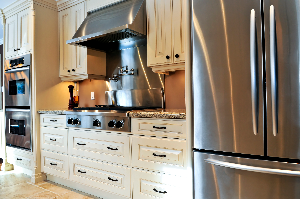Turning your water heater down, installing LED light bulbs, and checking to see which appliances and electronics waste electricity on standby are great first steps towards a more efficient home. However, did you know that some appliances, such as your refrigerator and dishwasher, can waste energy while they’re running–and in totally preventable ways?
This post lists three ways those kitchen appliances could be wasting electricity.
- Running an Extra Motor in Your Freezer
If you have an icemaker, then your freezer has a motor inside it, and this motor runs even when it’s not needed. Even though the icemaker doesn’t need to constantly produce ice, the motor is likely to remain on at all times so that the appliance can be ready to produce ice at a moment’s notice.
While the icemaker wastes the energy it takes to run the motor, the motor is also a heat source, which means the freezer has to work significantly harder to keep your food frozen.
Although newer models are increasingly energy-efficient, you may still be able to save money by manually turning the icemaker off when it’s not needed.
- Drying Your Dishes With Hot Air
Dishwashers are among the greatest of modern laborsaving devices. It’s super convenient to be able to put your dishes in the dishwasher and then get them back clean, dry, and warm. However, if you’ll settle for just clean and warm, you can get a lot more energy efficiency out of this appliance, helping you save that little bit more on your electric bill.
Dishwashers dry your dishes by heating up the interior of the appliance, which forces the extra water to evaporate off of your dishes. This is accomplished by either an electric heating coil or, in newer models especially, extra hot water at the end of the cycle to help the dishes dry faster.
Either way, all that heat is unneeded. Just turn the dishwasher off once it reaches the drying part of the cycle, then open the door and let the dishes air dry. Alternatively, if you have a newer model, you may be able to run an energy-saving or eco cycle option. Try this cycle and see if it lets the dishes air dry. It may also save water as well.
- Building Up Dirt and Grime
Don’t discount this possibility just because you’re a good housekeeper. Even if you’re great about disinfecting your countertops and sinks, it can be easy to overlook some critical areas.
While you may scrub out your refrigerator every couple of months, do you remember to move it away from the wall and clean off its coils? Coil cleaning is a recommended task that you should do twice a year, but it’s very easy to forget. However, the dirtier the coils are, the more electricity your fridge uses to keep things cool.
Ovens are another example. The oven’s interior has reflective surfaces that are designed to reflect heat back towards its interior, saving on electrical costs. When the surfaces become stained or blackened, they can’t reflect as well. One way to increase the energy efficiency of your oven is to clean it more often. This same principle is true for the for the metal burner pans on your stovetop; keep them shiny for best results.
Even your dishwasher can become less efficient if it manages to accumulate dirt. Be sure to give it a deep cleaning occasionally.
These are just three ways in which your kitchen appliances could be wasting your electricity and increasing your monthly bills. If you’d like advice on installing new appliances or other efficiency upgrades, give A To Z Electric Co. a call today or get in touch online. We’re available to help you all day, seven days a week.

